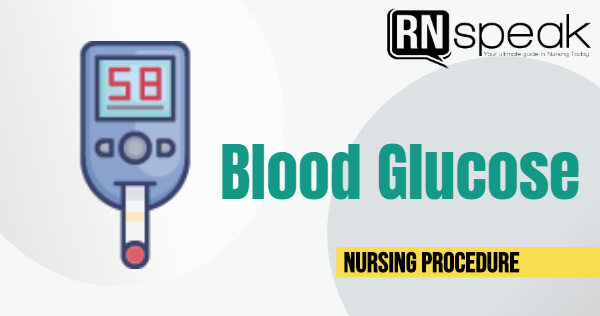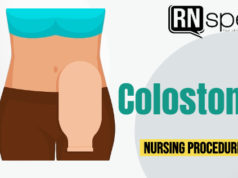Monitoring blood glucose levels regularly is a necessity for diabetic clients. The readings provided in each test determine the best strategy in managing blood sugar levels. Changes in glucose level pattern can alert health professionals to a possible need for alterations in managing diabetes.
Blood glucose monitoring procedure detect or monitor elevated blood glucose levels in clients with diabetes, screen for diabetes mellitus and neonatal hypoglycemia, and distinguish diabetic coma from a nondiabetic coma. This procedure can be done in hospitals, clinics, or at home. Testing a client’s blood glucose levels help to:
- Develop confidence in looking after the diabetic client
- Understand the relationship between blood glucose levels and the amount of exercise done by the client, the food intake, medications are taken and lifestyle
- Immediately detect if a client’s blood sugar levels are too high (hyperglycemia) or too low (hypoglycemia)
- Alert physician if the regimen is effective or not based on the series of test results
In a blood glucose test, a plastic strip that’s inserted into a portable blood glucose meter such as Glucometer, Accu-check, and OneTouch, provides the quantitative measurements that compare in accuracy with other laboratory tests. Some meters can store successive results electronically to help in determining the glucose patterns of clients.
Related Physiology
Glucose is important for cell metabolism. Normal blood glucose levels is <110 mg/dl. Hyperglycemia (high blood sugar) takes place when blood glucose levels is greater than 130 mg/dl. Hypoglycemia (low blood sugar) occurs when blood sugar goes down to 70 mg/dl or lower.
Signs of hyperglycemia are:
- Reduced consciousness
- Confusion
- Polydipsia
- Polyuria
Signs of hypoglycemia are:
- Confusion
- Dizziness
- Feeling shaky
- Hunger
- Headaches
- Irritability
- Pounding heart; racing pulse
- Pale skin
If high blood sugar is not managed, it may develop into diabetic ketoacidosis with clinical manifestations such as hyperventilation, nausea and vomiting, and diarrhea.
Blood Glucose Monitoring Procedure
Equipment:
- Reagent strips
- Gloves
- A portable blood glucose meter
- Alcohol pads
- Gauze pads
- Disposable lancets or mechanical blood-letting device
- Small adhesive bandage
- Watch or clock with a second hand
Key steps:
- Confirm the client’s identity. Use two client identifiers according to your facility’s policy.
- Explain the procedure to the client to gain cooperation.
- Select the puncture site. The usual puncture sites are fingertips and earlobes. For infants, the heel or great toe is used.
- Wash your hands and put on gloves to prevent the transmission of microorganisms.
- Apply warm and moist compresses to the area for about 10 minutes to dilate the capillaries.
- With an alcohol pad, wipe the puncture site. Dry it with a gauze pad.
- Collect a sample of blood from the puncture site. Position lancet to the side of the client’s fingertip, perpendicular to the lines of the fingerprints. Quickly, pierce the skin sharply. This step should be done quickly to minimize client anxiety and pain. If you have a mechanical bloodletting device, a spring-loaded lancet is used. NOTE: Don’t squeeze the puncture site to avoid diluting the sample with tissue fluid.
- Touch a drop of blood to the reagent strip. The entire patch should be covered.
- After the blood sample is collected, pressure should be applied to the puncture site to prevent painful extravasation of blood into subcutaneous tissues. Ask the client (if adult) to hold the gauze pad firmly over the puncture site until bleeding stops.
- Leave the blood on the strip for about 60 seconds.
- Compare the color change on the strip with a standardized color chart on the glucose meter. If a blood glucose meter is used, follow the manufacturer’s instructions. Presently, most glucose meters used have a digital display of the result. Although meter designs may vary, all of them analyze a drop of blood placed on a reagent strip that comes with the unit.
- When the bleeding on the puncture site has stopped, place a small adhesive bandage on it.
Special Considerations:
- Check the test/reagent strips for expiration before using it. Protect the strips from light, heat, and moisture.
- Avoid selecting cold, cyanotic, or swollen puncture sites to ensure an adequate blood sample. If you can’t obtain a capillary sample, a venipuncture can be performed and place a large drop of venous blood on the strip.
- When using blood from a refrigerated sample, allow the blood to return to room temperature before testing it.
Nurses performing blood glucose monitoring procedure should only do so if they have enough experience to be deemed competent. Practice should also always be in concordance with the facility’s policy.




![Caring for Patients with Tracheostomy and Nursing Diagnoses [ Updates] tracheostomynursingprocedure](https://rnspeak.com/wp-content/uploads/2020/10/tracheostomynursingprocedure_725820712-238x178.jpg)



